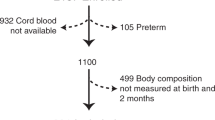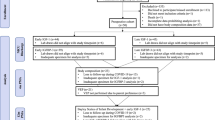Abstract
Background/objectives
To ascertain associations between plasma insulin-like growth factor I (IGF-I), insulin-like growth factor-binding protein 3 (IGFBP-3) and their molar ratio at 2 y with neonatal size, infant growth, body composition at 2 y, and feeding practices in an Indian cohort.
Subjects/methods
A cohort of 209 newborns, with 122 followed at 2 y. Anthropometry was conducted at birth and 2 y. IGF-I and IGFBP-3 concentrations were measured in cord blood and at 2 y. Maternal and child diet was assessed by food frequency questionnaires and maternal interviews. Multivariate regression was used to test for associations adjusting for confounding factors.
Results
Mean 2 y plasma IGF-I and IGFBP-3 concentrations and IGF-I/IGFBP-3 were 49.4 ng/ml (95% CI: 44.1, 54.8), 1953.8 ng/ml (CI: 1870.6, 2036.9) ng/ml, and 0.088 (CI: 0.081, 0.095), respectively. IGF-I and IGF-I/IGFBP-3 were positively associated with current length, but not body mass index or adiposity. IGF-I was higher among those with greater change in length since birth. IGF-I concentrations were higher in children who drank the most milk (>500 vs. <250 ml per day: 65.6 vs. 42.8 ng/ml, p < 0.04), received other milk <6 months compared to ≥6 months (56.3 vs. 44.8 ng/ml, p < 0.05), and in those whose mothers consumed milk daily vs. less frequently in late pregnancy (56.4 vs. 42.7 ng/ml, p < 0.01). In multivariate regression, 2 y IGF-I concentration and IGF-I/IGFBP-3 were each positively associated with current length and milk intake. IGFBP-3 was not related to anthropometry or milk intake.
Conclusions
Plasma IGF-I concentrations and IGF-I/IGFBP-3 at 2 y are positively associated with length at 2 y and current milk intake.

Similar content being viewed by others
References
Puche J, Castilla-Cortazar I. Human conditions of insulin-like growth factor-I (IGF-I) deficiency. J Transl Med. 2012;10:224.
Ejlerskov KT, Larnkjaer A, Pedersen D, Ritz C, Molgaard C, Michaelsen KF. IGF-I at 9 and 36months of age—relations with body composition and diet at 3years—the SKOT cohort. Growth Horm IGF Res. 2014;24:239–44.
Ong KK, Langkamp M, Ranke MB, Whitehead K, Hughes IA, Acerini CL, et al. Insulin-like growth factor I concentrations in infancy predict differential gains in body length and adiposity: the Cambridge Baby Growth Study. Am J Clin Nutr. 2009;90:156–61.
Hoppe C, Udam TR, Lauritzen L, Mølgaard C, Juul A, Michaelsen KF. Animal protein intake, serum insulin-like growth factor I, and growth in healthy 2.5-y-old Danish children. Am J Clin Nutr. 2004;80:447–52.
Wang X, Xing KH, Qi J, Guan Y, Zhang J. Analysis of the relationship of insulin-like growth factor-1 to the growth velocity and feeding of healthy infants. Growth Horm IGF Res. 2013;23:215–9.
Fall CHD, Pandit AN, Law CM, Yajnik CS, Clark PM, Breier B, et al. Size at birth and plasma insulin-like growth factor-1 concentrations. Arch Dis Child. 1995;73:287–93.
Chellakooty M, Juul A, Boisen KA, Damgaard IN, Kai CM, Schmidt IM, et al. A prospective study of serum insulin-like growth factor I (IGF-I) and IGF-binding protein-3 in 942 healthy infants: associations with birth weight, gender, growth velocity, and breastfeeding. J Clin Endocrinol Metab. 2006;91:820–6.
Ong K, Kratzsch J, Kiess W, Dunger D, ALSPAC Study Team. Circulating IGF-I levels in childhood are related to both current body composition and early postnatal growth rate. J Clin Endocrinol Metab. 2002;87:1041–4.
Madsen AL, Larnkjaer A, Molgaard C, Michaelsen K F. IGF-I and IGFBP-3 in healthy 9 month old infants from the SKOT cohort: breastfeeding, diet, and later obesity. Growth Horm IGF Res. 2011;21:199–204.
Fowden AL. The insulin-like growth factors and feto-placental growth. Placenta. 2003;24:803–12.
Murray PG, Clayton PE. Endocrine control of growth. Am J Med Genet C: Semin Med Genet. 2013;163:76–85.
Larnkjaer A, Hoppe C, Molgaard C, Michaelsen KF. The effects of whole milk and infant formula on growth and IGF-I in late infancy. Eur J Clin Nutr. 2009;63:956–63.
Savino F, Nanni GE, Maccario S, Oggero R, Mussa GC. Relationships between IGF-I and weight Z score, BMI, tricipital skin-fold thickness, type of feeding in healthy infants in the first 5 months of life. Ann Nutr Metab. 2005;49:83–7.
Socha P, Grote V, Gruszfeld D, Janas R, Demmelmair H, Closa-Monasterolo R, et al. Milk protein intake, the metabolic-endocrine response, and growth in infancy: data from a randomized clinical trial. Am J Clin Nutr. 2011;94(Suppl):1776s–84s.
Wiley A. S, Lubree H. G, Joshi S. M, Bhat D. S, Ramdas L. V, Rao A. S. et al. Cord IGF-I concentrations in Indian newborns: associations with neonatal body composition and maternal determinants. Pediatr Obes. 2016;11:151–7.
Friedrich N, Wolthers OD, Arafat AM, Emeny RT, Spranger J, Roswall J, et al. Age- and sex-specific reference intervals across life span for Insulin-Like Growth Factor Binding Protein 3 (IGFBP-3) and the IGF-I to IGFBP-3 ratio measured by new automated chemiluminescence assays. J Clin Endocrinol Metab. 2014;99:1675–86.
Katre P, Bhat D, Lubree H, Otiv S, Joshi SJ, Joglekar C, et al. Vitamin B12 and folic acid supplementation and plasma total homocysteine concentrations in pregnant Indian women with low B12 and high folate status. Asia Pac J Clin Nutr. 2010;19:335–43.
Lubree HG, Katre PA, Joshi SM, Bhat DS, Deshmukh US, Memane NS, et al. Child’s homocysteine concentration at 2 years is influenced by pregnancy vitamin B12 and folate status. J Dev Orig Health Dis. 2012;3:32–8.
Department of Biometry and Nutrition. Nutritive values of some Indian food preparations. Pune, India: Maharashtra Association for the Cultivation of Science, Agharkar Research Institute; 1992.
International Institute for Population Sciences and ORC Macro. National Family Health Survey (NHFS-2), India 1998-99, Mumba; 2001.
WHO Multicentre Growth Reference Study Group. WHO child growth standards: length/height-for-age, weight-for-age, weight-for-length, weight-for-height and body mass index-for-age: methods and development. 2006. http://www.who.int/childgrowth/standards/technical_report/en/index.html.
Batista RFL, Silva AAM, Barbieri MA, Simões VMF, Bettiol H. Factors associated with height catch-up and catch-down growth among schoolchildren. PLoS ONE. 2012;7:e32903.
STATACorp I. STATA 13: STATACorp LP; 2013 [updated 2013]. http://www.stata.com/.
National Institute of Nutrition. Dietary Guidelines for Indians 2010. 23 May 2013. http://www.indg.gov.in/health/nutrition/dietary-guidelines-for-indians.
Yajnik CS, Fall CH, Coyaji KJ, Hirve SS, Rao S, Barker DJ, et al. Neonatal anthropometry: the thin-fat Indian baby. The Pune Maternal Nutrition Study. Int J Obes Relat Metab Disord. 2003;27:173–80.
Patel L, Whatmore A, Davies J, Bansal N, Vyas A, Gemmell I, et al. Circulating insulin-like growth factor-binding protein 3 levels, independent of insulin-like growth factor 1, associate with truncal fat and systolic blood pressure in South Asian and White European preschool children. Horm Res Paediatr. 2014;81:109–17.
Brand-Miller JC, Liu V, Petocz P, Baxter RC. The glycemic index of foods influences postprandial insulin-like growth factor-binding protein responses in lean young subjects. Am J Clin Nutr. 2005;82:350–4.
Holmes MD, Pollak MN, Willett WC, Hankinson SE. Dietary correlates of plasma insulin-like growth factor I and insulin-like growth factor binding protein 3 concentrations. Cancer Epidemiol Biomark Prev. 2002;11:852–61.
Wattiaux MA. Milk composition and nutritional value. In: Babcock Institute, editor. Dairy essentials. Madison, WI: Babcock Institute for International Dairy Research and Development; 2011. http://babcockwiscedu/node/198.
Hawkes CP, Grimberg A. Measuring growth hormone and insulin-like growth factor-I in infants: what is normal? Pediatr Endocrinol Rev Per. 2013;11:126–46.
Juul A, Bang P, Hertel NT, Main K, Dalgaard P, Jørgensen K, et al. Serum insulin-like growth factor-I in 1030 healthy children, adolescents, and adults: relation to age, sex, stage of puberty, testicular size, and body mass index. J Clin Endocrinol Metab. 1994;78:744–52.
Ben-Shlomo Y, Holly JMP, McCarthy A, Savage P, Davies D, Davey Smith G. Prenatal and postnatal milk supplementation and adult insulin-like growth factor I: long-term follow-up of a randomized controlled trial. Cancer Epidemiol Biomark Prev. 2005;14:1336–9.
Joslowski G, Remer T, Assmann KE, Krupp D, Cheng G, Garnett SP, et al. Animal protein intakes during early life and adolescence differ in their relation to the growth hormone-insulin-like-growth-factor axis in young adulthood. J Nutr. 2013;143:1147–54.
Acknowledgements
We are grateful to Lalita Ramdas, who provided logistical support for data collection.
Funding
The study was funded by the International Atomic Energy Agency (IAEA). Analysis of IGF-I was funded by Indiana University.
Author contributions
CSY designed research; HGL, DSB, NSM, and DAR conducted research; ASW provided IGF-I analysis kits; ASW and SMJ analyzed data; ASW wrote paper; ASW, SMJ, and CSY had primary responsibility for the final content. ASW and CSY have equal authorship status.
Author information
Authors and Affiliations
Corresponding author
Ethics declarations
Conflict of interest
The authors declare that they have no conflict of interest.
Ethics
The study was approved by the KEM Hospital Research Centre Ethics Committee, Pune, India and informed written consent was obtained from mothers in the study. Analysis of the umbilical cord and 2-y blood samples for IGF-I concentration was approved by the Institutional Review Board at Indiana University, Bloomington, IN, USA.
Electronic supplementary material
Rights and permissions
About this article
Cite this article
Wiley, A.S., Joshi, S.M., Lubree, H.G. et al. IGF-I and IGFBP-3 concentrations at 2 years: associations with anthropometry and milk consumption in an Indian cohort. Eur J Clin Nutr 72, 564–571 (2018). https://doi.org/10.1038/s41430-018-0108-z
Received:
Revised:
Accepted:
Published:
Issue Date:
DOI: https://doi.org/10.1038/s41430-018-0108-z
- Springer Nature Limited
This article is cited by
-
Milk and dairy consumption is positively associated with height in adolescents: results from the Israeli National Youth Health and Nutrition Survey
European Journal of Nutrition (2022)




